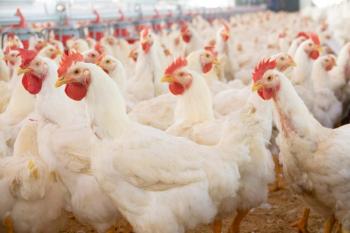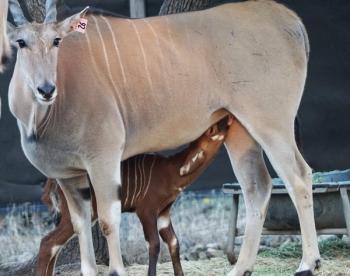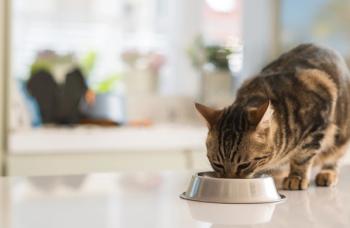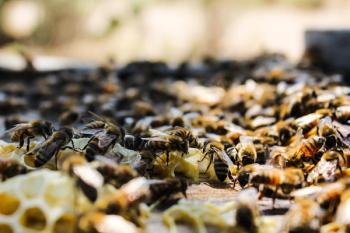
Avian reproduction and reproductive diseases (Proceedings)
Psittacine breeding has developed to fill the large demand for pet parrots created by the ban on importation. Many breeding pairs of birds are maintained in aviaries specifically to produce chicks for sale as pets.
Psittacine breeding has developed to fill the large demand for pet parrots created by the ban on importation. Many breeding pairs of birds are maintained in aviaries specifically to produce chicks for sale as pets. However, the average parrot owner is not interested in breeding their bird and simply wants a happy, healthy pet. Breeding is a natural behavior for birds and has several environmental triggers. Because parrots are not routinely spayed or neutered like our domestic mammal pets, unwanted reproductive associated behavior and reproductive problems may develop once sexual maturity is reached.
Avian sexing techniques
Birds do not possess external reproductive organs and all but a few species are sexually monomorphic making distinguishing males from females difficult. Those species that are sexually dimorphic may possess different plumage coloring between males and females or may have a palpable copulatory organ, or phallus, as is the case with ratites, poultry, and waterfowl. Knowing the sex of the patient may be beneficial to the avian practitioner and give owners useful information to use when interacting with their bird. Several techniques for sex determination in the bird are available.
Blood sexing is a non-invasive technique that evaluates the DNA of blood cells to determine the sex of the bird. Sex differentiation is based on chromosomes, as male birds carry the sex chromosomes ZZ, while females carry the ZW chromosome. Analysis of many different species, including most psittacine species, has been performed making this test highly accurate. Assessment of the health of the reproductive organs is not possible with this test. Surgical sexing, with the use of an endoscope, is commonly performed and offers the added benefit of actual visualization of the reproductive organs, in addition to sex determination. If abnormalities are noted, biopsy samples can be obtained.
Male reproductive tract and disease
Male birds contain two testes located dorsally in the coelom, cranially and medial to the kidneys. The testes undergo breeding seasonal enlargement which may be significant is some species. Avian sperm are flagellated and possess long rectangular heads. Sperm production occurs at night when the body temperature is reduced and the sperm is stored in the distal part of the ductus deferens (seminal glomus) where the temperature is lower than body temperature. Copulation occurs through cloacal apposition and only a few species possess a phallus. Infertility can be caused by a physical problem preventing successful copulation or it may relate to sperm production and health. Problems such as testicular disease, cloacal pathology, or orthopedic issues may contribute to infertility.
Testicular neoplasia is uncommon in most species of psittacines except the budgerigar. Several types of cancer have been described including Sertoli cell tumors, seminomas, interstitial cell tumors, and lymphosarcomas. Testicular neoplasia is most often unilateral, distinguishing it from seasonal hypertrophy which is bilateral. Clinical signs of neoplasia include coelomic distension and unilateral hind limb lameness caused by paresis or paralysis secondary to ishiatic nerve compression. Radiographic evaluation may reveal a soft tissue mass but diagnosis is made via endoscopy and biopsy. Treatment involves an orchiectomy; veterinarians inexperienced in this procedure should consider referral to a specialty surgeon. Conclusive data is not available regarding chemotherapy for this condition although carboplatin has been used in several cases. Orchitis is rarely seen and usually has a bacterial etiology. Infection is usually via hematogenous spread as the testes are in a well-protected location. Clinical signs are non-specific and may be difficult to specifically diagnose without biopsy. Treatment with antibiotics is usually effective but infertility is a possible sequela.
Female reproductive tract
Most female parrots possess an ovary and oviduct typically on the left side only. Developing follicles on the ovary are engulfed by the infundibulum of the oviduct immediately post ovulation. From there, the follicle passes through the magnum and isthmus while components of the egg (albumin, shell membranes) are deposited. After approximately four hours, the egg passes into the shell gland (uterus) where it remains for 18-20 hours while the shell is being formed. Oviposition, or egg delivery, occurs within four hours of the egg being fully shelled and involves movement of the egg through the vagina, into the cloaca, and out of the body. Normally, eggs are laid every 48-72 hours until an entire clutch is laid. Clutch size depends on the species and individual bird. The stimulus to lay eggs is due to a complex series of conditions including hormone levels and their related physiology as well as behavioral actions relating to photoperiod, nest sites, and food availability. A mate is not necessary for egg laying behavior. During egg-laying, the hen may be seen nest-building and her behavior may become more aggressive. The bird may spend significantly more time on the floor of the cage and may be slightly fluffed in appearance. Straining behavior may be exhibited but this should not be excessive or persistent. Normal passage of droppings may be observed during egg-laying but the droppings may contain more urine than normal. The hen should continue to eat during this time.
Egg binding
Egg binding occurs when the egg's passage through the oviduct is delayed, whereas dystocia occurs when the progress of the egg becomes physically impeded. This can occur anywhere in the oviduct or cloaca because of egg malformation or abnormal structure or function of the oviduct. Clinical signs of egg binding occur as the hen becomes distressed and fatigued from prolonged straining. Clinical signs commonly include straining, coelomic swelling, and ruffled feathers. A shelled egg may or may not be palpable in the caudal coelom or cloaca. If a hard shell is palpable, the egg must be in or distal to the uterus (shell gland) as this is where the shell is deposited on the egg. The presence of multiple shelled eggs indicates that the integrity of the oviduct has been compromised. Radiographic evaluation is a useful diagnostic tool for diagnosing dystocia. If the hen is not passing droppings, the egg may be blocking the outflow of intestines or ureters. This can lead to life threatening problems due to toxic shock or post-renal uricemia. Hens that demonstrate excessive straining are prone to cloacal or oviductal prolapse.
Veterinary intervention for an egg bound bird is recommended. Management depends on the condition of the patient when presented. If the hen is stable, with good peripheral perfusion and no signs of distress, conservative therapy is appropriate. Subcutaneous fluid therapy to replace loss and to maintain tissue hydration is indicated (60 ml/kg/day maintenance). In most cases, the hen has reduced her calcium stores through egg production and muscle contractions thus calcium supplementation is beneficial in restoring appropriate smooth muscle contractions for egg delivery (calcium gluconate 5-10 mg/kg IM). Arginine vasotocin and oxytocin are the natural hormones stimulating contractions in birds. Oxytocin (2 IU/kg, IM) will increase the strength and frequency of uterine contractions. Oxytocin does not cause uterovaginal sphincter relaxation so caution must be used to ensure that there is no obstruction to egg passage. A single injection may be effective in initiating egg delivery but a second injection 12 hours later is indicated if the egg is not laid and the bird remains in stable condition. Oil based lubricants should be avoided as these are largely ineffective and can reduced the insulating effects of the feathers. Water based lubricant can be applied to the cloacal area to maintain moistness of tissues if indicated. If the bird's condition decompensates at any time during therapy or if conservative therapy fails, assisted egg delivery should be performed.
If the hen is unstable, she should receive IV or IO fluid therapy at a rate suitable for her condition. Antibiotic therapy, anti-inflammatory therapy, and supplemental heat are often indicated. Assisted egg delivery can be performed in several ways. Ovocentesis involves aspirating the egg content to the point of shell implosion which allows the pressure on the oviduct to be relieved and the egg to pass out of the cloaca. General anesthesia greatly enhances the ease of the procedure while minimizing the stress to the patient. An 18 or 20 gauge needle is inserted into the egg via vagina or transdermally in the caudal coelom. The contents are aspirated and the egg is collapsed with digital pressure. The egg remnants are generally passed within 48-72 hours or can be removed via the cloaca manually. Occasionally, the egg is lodged in the cloaca and can be delivered with gentle manipulation. When oviposition fails, or if multiple shelled eggs are present but not accessible via the cloaca, a cesarean section surgery or salpingectomy surgery is indicated. C-sections are reserved for birds with significant breeding value and are not performed routinely. In most cases, preventing future egg laying is desired and the oviduct is removed. Ovary removal is not routinely performed due to the significant risk of hemorrhage.
Once the egg binding episode has been managed, regardless of the method, continued egg production must be stopped. In most cases, the condition of the hen would not support continued bouts of dystocia. Hormone therapy is usually indicated. Several options are available for the practitioner and will be discussed in the chronic egg laying section.
Chronic egg laying
Chronic egg laying occurs when the hen lays clutches that are larger than normal size, laid with decreased clutch intervals, or continually lays without regard for breeding season or clutch size. Chronic egg laying places significant burden on the hen's energy and nutritional reserves and can lead to egg binding, egg yolk peritonitis, osteoporosis, and immune compromise. Birds fed a nutritionally deficient diet, such as seed based diets, are highly predisposed to problems secondary to egg laying behavior. There may be a genetic predisposition of some species of birds to become chronic egg layers. Cockatiels, finches, and lovebirds are species that are over-represented for this condition.
Treatment of chronic egg laying is multi-tiered. The first level of management is modification of behavioral and environmental stimuli. This has the most effect on species that display a defined breeding season but has less effect on year-round breeders such as cockatiels. Hormonal and environmental factors must be addressed to discourage egg laying. Several measures can be implemented until egg laying behavior ceases. They are as follows:
- Decreased photoperiod –Limit exposure to natural or artificial light to 8-10 hours per day. The bird must be kept in complete darkness at all other times.
- Disrupt the environment – Move the cage or change the location and type of cage furnishing to create a less stable environment that is less reproductively stimulating. This should continue periodically after egg laying behavior has stopped.
- Decrease the moisture and caloric content of food – Foods high in moisture and calories are a stimulus for egg laying behavior. Convert the bird from a seed to a pellet diet and restrict calories to those needed for daily maintenance.
- Remove stimulatory objects – Nest material, toys, or other items to which the bird has a sexual affinity should be removed from the cage. If the stimulus is another bird in the household, separate the birds from audio and visual contact.
- Avoid stimulatory behavior – Avoid stroking or petting the bird. Encourage games and healthy interactions between the bird and a variety of other people.
Some birds will not respond to these changes or the response will only be temporary. In those cases, hormone therapy may be elected. Historically, medroxyprogesterone acetate (Depo-Provera), mibolerone (Cheque drops), and human chorionic gondadotropin (HCG) have all been used to stop egg production. These were associated with either serious side effects or limited usefulness. Leuprolide acetate is a long-acting gonadotropin-releasing hormone (GnRH) analog that has been used effectively for chronic egg laying in hens. Lupron Depot (TAP Pharmaceuticals) injections given monthly cause an initial stimulation of pituitary gonadotropins, followed by a prolonged suppression resulting in cessation of egg production. If hormone therapy is unavailable or egg laying continues, salpingohysterectomy may be necessary.
Prolapse
Cloacal or oviduct prolapse can occur when there is excessive or chronic straining. Potential etiologies include chronic egg laying, dystocia, cloacal pathology (papillomas), masturbation, or intra-coelomic masses. Oviductal prolapse is most common in small psittacines such as cockatiels and budgerigars. Initial evaluation includes identification of the prolapsed tissue and assessment of the viability of the tissue. Prolapses of the cloaca are generally shorter and rounder than oviduct prolapses which can extend 1-10 cm. Cloacal papillomas can look like prolapsed tissue but these have a rough surface. Gentle cleaning, debridement, and irrigation are necessary. Application of a water-based lubricant will help keep the tissue moist and will aid in the removal of adhered egg material. Once debrided and cleaned, the prolapsed tissue should be gently reduced. This can be successfully accomplished with the aid of a moist cotton-tipped applicator. Two transverse sutures are placed across the cloaca to reduce the diameter to 2/3 of the normal size. This will prevent re-prolapse while the inflammation and underlying etiology can be addressed. Monitor the patient to ensure that droppings can be evacuated from the cloaca and remove the sutures after two weeks. If the tissue is necrotic or devitalized it should not be reduced. In these cases, surgery to resect and anastomose healthy tissue should be performed. If the oviduct is necrotic, a salpingohysterectomy can be performed concurrently. Medical management with antibiotics, anti-inflammatories, and fluid therapy is indicated.
Egg-related coelomitis
When an ovulated egg is not engulfed by the infundibulum, the ovum becomes ectopic and is deposited into the coelom. The presence of the foreign protein (egg yolk) in the body cavity induces an inflammatory process. This condition is most commonly reported in cockatiels, budgerigars, lovebirds, and macaws. Clinical signs may include coelomic swelling caused by ascites, lethargy, depression, and anorexia, although not all signs are seen in all cases. Respiratory distress can occur secondary to compression of the air sac space by the coelomic swelling. Occasionally, the condition results in neurological signs consistent with central nervous system disease (head tilt, nystagmus, circling), sometimes referred to as “yolk stroke”, secondary to a yolk emboli in a cerebral blood vessels. Coelomitis may be non-septic or septic and severe debilitation and death may occur if the coelomitis has a bacterial component. Coliforms are the most commonly implicated bacteria. Diagnostically, hematology may reveal a pronounced inflammatory response with a mature heterophilia, hyperproteinemia, and lipemia. Often the plasma has the appearance of egg yolk material. Radiography demonstrates a loss of serosal detail due to fluid accumulation but ultrasonography may prove useful in further visualization of disease. Abdominocentesis often produces a yolk-like fluid that represents an inflammatory exudate with high protein content. In addition to its diagnostic value, abdominocentesis provides relief of respiratory signs as the fluid is removed. Treatment of egg related coelomitis involves the immediate interruption of egg production, antibiotic, anti-inflammatory, and fluid therapy with supportive care. Surgery to remove the deposition of inspissated yolk material and by-products of the inflammatory response is necessary in many cases once the patient is stable.
Cystic and neoplastic conditions of the female reproductive tract
Neoplasia of the reproductive tract is common in budgerigars. Clinical signs included coelomic distension, ascites, dyspnea, and other signs of malaise. Left leg lameness may be noted. Other reproductive system pathology may be concurrent with the neoplasia. Cystic ovarian disease is common in cockatiels, canaries, and budgerigars. The underlying cause may be hormonal, neoplastic, or may be related to physical abnormalities on the ovary. Ascites, with dyspnea, is often noted and abdominocentesis reveals a straw-colored transudate. Radiographic evaluation may demonstrate a space occupying mass in the location of the ovary and the bones may show polyostotic hyperostosis. Endoscopy with biopsy is diagnostic in these cases. Alternatively, exploratory surgery with aspiration of cysts and salpingohysterectomy may result in resolution of clinical disease.
Resources
Avian Medicine: Principles and Application. Ritchie B.W., Harrison G.J., Harrison L.R., eds. 1994. Wingers Publishing Co., Lake Worth, FL.
Avian Medicine and Surgery. Altman R.B., Clubb S.L., Dorrestein G.M., Quesenberry K., eds. 1997. W.B. Saunders Co., Philadelphia, PA.
The Veterinary Clinics of North America, Exotic Animal Practice; Reproductive Medicine. Speer B.L., ed. 2002. W.B. Saunders Co., Philadelphia, PA.
Newsletter
From exam room tips to practice management insights, get trusted veterinary news delivered straight to your inbox—subscribe to dvm360.






